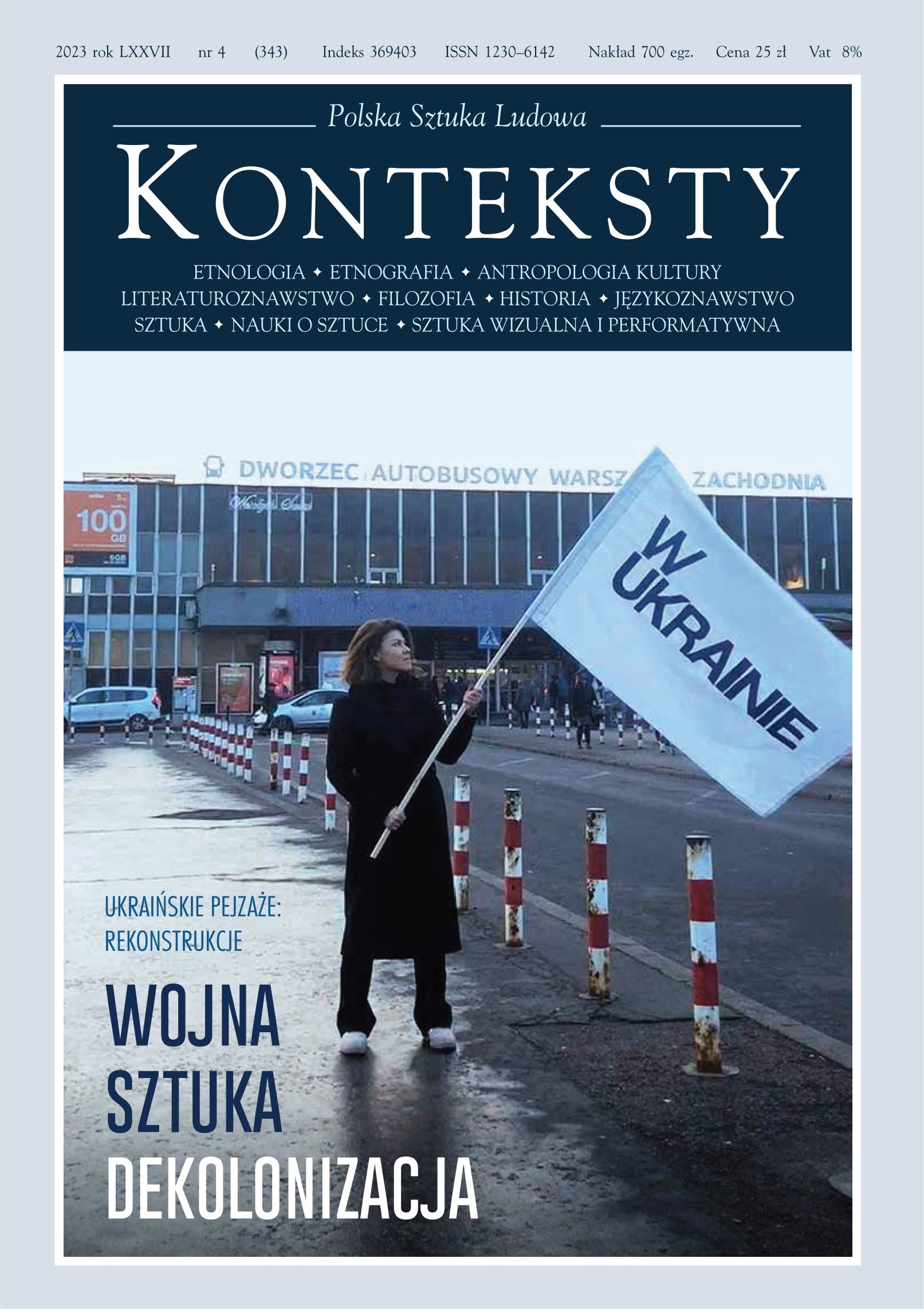Mise Éire: wizje i rewizje patriotycznego mitu w poezji irlandzkiej
Maria Fengler
maria.fengler@ug.edu.plUniwersytet Gdański (Polska)
https://orcid.org/0000-0001-5009-9705
Abstrakt
Celtycki mit bogini uosabiającej irlandzką ziemię przenika irlandzką literaturę od najdawniejszych podań do XX wieku. Analizowane tu wiersze z lat 70. i 80. XX wieku uwidaczniają jednak bunt wobec mitu i projektowanych przezeń społecznych i politycznych postaw, defamiliaryzując narodową narrację poprzez strategie demitologizacji, groteskę i szyderstwo. Wiersz Bog Queen Seamusa Heaneya zamienia boginię w przerażające zombie patronujące rytualnej przemocy, zaś Aisling Paula Muldoona w anorektyczną wizję prowadzącą młodych mężczyzn na męczeńską śmierć. Eavan Boland demitologizuje postać Matki Irlandii, ukazując w jej miejsce historyczne losy Irlandek: prostytutki i matki-emigrantki. W prześmiewczym ujęciu Nuali Ní Dhomhnaill, Irlandia to Stara Bezzębna Babcia, ślepa i głucha na współczesną rzeczywistość. Poetyckie rewizje mitu diagnozują wyczerpanie narodowej ideologii, wskazując na ludzki koszt sakralizowanej przemocy oraz na anachronizm wezwania do krwawej ofiary we współczesnym świecie.
Słowa kluczowe:
Matka Irlandia, Cathleen Ni Houlihan, aisling, defamiliaryzacja, współczesna poezja irlandzkaBibliografia
Boland, Eavan. Object Lessons: The Life of the Woman and Poet in Our Time. Manchester: Carcanet Press, 1995.
Google Scholar
Boland, Eavan. The Journey and Other Poems. Dublin: Arlen House, 1987.
Google Scholar
Brewster, Scott. “Abject State: Ritual, Waste and Exile of the Body in Northern Irish Poetry”. In The Body and Desire in Contemporary Irish Poetry, edited by Irene Gilsenan Nordin, 21-39. Dublin: Irish Academic Press, 2006, s. 27-28.
Google Scholar
Brown, Terence. Ireland: A Social and Cultural History 1922-1985. London: Fontana Press, 1985.
Google Scholar
Clark, Rosalind. The Great Queens: Irish Goddesses from the Morrigan to Cathleen Ni Houlihan. Gerrards Cross: Colin Smythe, 1991.
Google Scholar
Clutterbuck, Catriona. “'Mise Eire', Eavan Boland”, Irish University Review, 39, no. 2, (Autumn/Winter 2009): 289-300. https://www.jstor.org/stable/20720408
Google Scholar
Corkery, Daniel. The Hidden Ireland. Dublin: Gill and Macmillan, 1996 (first published 1924).
Google Scholar
Dalton, G. F. “The Tradition of Blood Sacrifice to the Goddess Éire”, Studies: An Irish Quarterly Review, 63, no. 252 (Winter, 1974): 343-354.
Google Scholar
Fulford, Sarah. “Woman and Nation: Readings of Authenticity in Contemporary Irish Poetry”, Studies: An Irish Quarterly Review, 89, No. 354 (Summer, 2000): 130-139. https://www.jstor.org/stable/30095346
Google Scholar
Gender and Sexuality in Modern Ireland, edited by Anthony Bradley and Maryann Gialanella Valiulis. Amherst: University of Massachusetts Press, 1997.
Google Scholar
Glob, P.V., The Bog People, translated by Rupert Bruce-Mitford. Ithaca, New York: Cornell University Press, 1969.
Google Scholar
Green, Miranda. Celtic Goddesses: Warriors, Virgins and Mothers. London: British Museum Press, 1995.
Google Scholar
Gutorow Jacek, „Seamus Heaney: tożsamość i archiwum.” In Poszukiwanie sensów: lekcja z czytania kultury, red. Piotr Kowalski, Zbigniew Libera. Kraków: Wydawnictwo Uniwersytetu Jagiellońskiego, 2006.
Google Scholar
Heaney, Seamus. North. London: Faber, 1992.
Google Scholar
Heaney, Seamus. Zawierzyć poezji, wybór i opracowanie Stanisław Barańczak. Kraków: Wydawnictwo Znak, 1996.
Google Scholar
Jarniewicz, Jerzy. The Bottomless Centre. Łódź: Wydawnictwo Uniwersytetu Łódzkiego, 2002.
Google Scholar
Levine, Joshua, “Europe’s Famed Bog Bodies Are Starting to Reveal Their Secrets”, Smithsonian Magazine, May 2017, https://www.smithsonianmag.com/science-nature/europe-bog-bodies-reveal-secrets-180962770/.
Google Scholar
Longley, Edna. “From Cathleen to Anorexia: The Breakdown of Irelands.” In The Living Stream: Literature and Revisionism in Ireland, 171-195. Newcastle upon Tyne: Bloodaxe Books, 1994.
Google Scholar
Mac Cana, Proinsias, “Aspects of the Theme of King and Goddess in Irish Literature”, Études celtiques, 7, no. 1, 1955: 76-114.
DOI: https://doi.org/10.3406/ecelt.1955.1274
Google Scholar
Muldoon, Paul. Quoof. London: Faber, 1983.
Google Scholar
Ní Dhomhnaill, Nuala. The Astrakhan Cloak, translated by Paul Muldoon. Winston-Salem: Wake Forest University Press, 1998.
Google Scholar
The New Oxford Book of Irish Verse, edited with translations by Thomas Kinsella. Oxford: Oxford University Press, 1989.
Google Scholar
Walter, Katharina. “From Aisling to Chora: Female Allegories of the Nation in Contemporary Irish Women’s Poetry”, Irish Studies Review, 2013: 1-13. http://dx.doi.org/10.1080/09670882.2013.814423
DOI: https://doi.org/10.1080/09670882.2013.814423
Google Scholar
Yeats, William Butler, Yeats’s Poems, edited by Norman A Jeffares. Dublin: Gill and Macmillan 1989.
Google Scholar
Yeats, William Butler. „Cathleen, córka Houlihana”, przeł. Zofia i Lucjan Porębscy. Dramaty irlandzkie, 10-15. Kraków-Warszawa: Instytut Książki, 2011.
Google Scholar
Autorzy
Maria Fenglermaria.fengler@ug.edu.pl
Uniwersytet Gdański Polska
https://orcid.org/0000-0001-5009-9705
Maria Fengler – anglistka, tłumaczka, adiunktka w Instytucie Anglistyki i Amerykanistyki Uniwersytetu Gdańskiego. Autorka nagrodzonej przez „Literaturę na Świecie” monografii irlandzkiego poety Michaela Longleya Między Itaką a Belfastem (2010) oraz artykułów na temat współczesnej poezji i prozy irlandzkiej; współredaktorka monografii wieloautorskich Między słowem a rzeczywistością. Poezja Eliota wobec cielesności i Wcielenia (2015) i Striking the Chords of Spirit and Flesh in Polish Poetry (2016); współredaktorka polskiego przekładu Towards a Christian Poetics M. Edwardsa (Ku poetyce chrześcijańskiej, 2017).
Statystyki
Abstract views: 407PDF downloads: 178
Licencja
Prawa autorskie (c) 2025 Maria Fengler

Utwór dostępny jest na licencji Creative Commons Uznanie autorstwa 4.0 Międzynarodowe.







